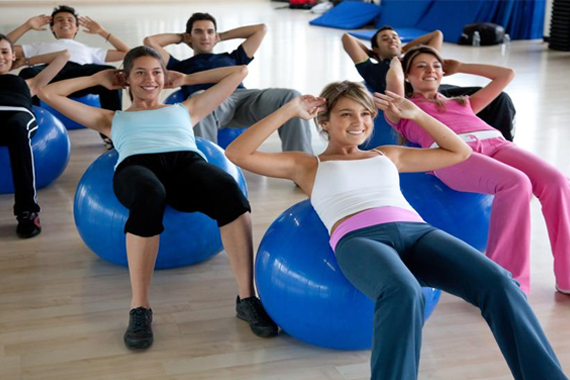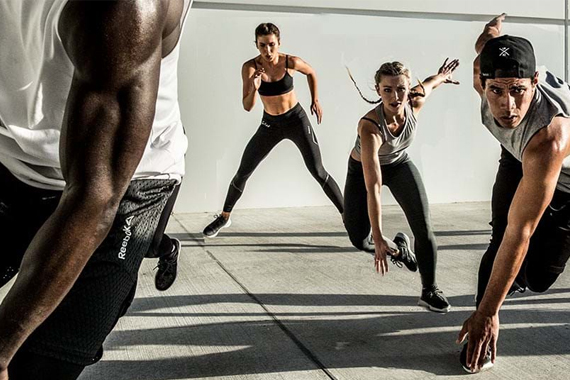Opening Hours - Morning 6am to 1pm | Evening 5pm to 8pm

Aerobic is a kind of physical exercise that integrates rhythmic aerobic exercise with stretching and strength training routines with the objective of improving all elements of fitness (flexibility, muscular strength, and cardio-vascular fitness). Generally it's performed in group with background music and this is directed by an instructor, although it can be practiced solo and without musical accompaniment. The Aerobic website provides you a lot of interesting resources about this fantastic sport.
There are many benefits, Aerobic exercise impulses the heart and circulatory system of the body. On our website you will discover benefits of Aerobics, types of aerobics, aerobic exercises, aerobic tips, fitness nutrition, aerobic and health, aerobic equipments and much more.

When it comes to losing weight, burning fat, and building muscle there are two styles of training I always recommend. The first style of training I tell people to begin with is strength training. It helps you lower your body fat percentage and build lean muscle, and it can be modified for all levels. "The benefits of strength training for both men and women include an increase in bone mass and lean mass, improved body composition (due to decreased fat mass), cardiovascular fitness, strength, and an enhanced sense of well-being,"

The most important thing you can do to gain weight is to create a calorie surplus, meaning you eat more calories than your body needs.
If you want to gain weight slowly and steadily, aim for 300–500 calories more than you burn each day according to the calculator.
If you want to gain weight fast, aim for around 700–1,000 calories above your maintenance level.

Cardiovascular fitness, also known as cardio-respiratory endurance, is a term that is used to describe a unique form of muscular endurance. In essence, it describes the efficiency in which the lungs, heart, and vascular system work in order to provide oxygen to the working muscles of the body so that the exertion of the muscle is able to be maintained.
Of course there are many factors that can affect cardiovascular fitness including heart rate, stroke volume, and the ability of the muscle cells to take up oxygen out of the blood. When we exercise our bodies in the aerobic threshold, which I will explain later, we cause several changes in our body to occur.

The floor refers to a specially prepared exercise surface, which is considered an apparatus. It is used by both male and female gymnasts. The event in gymnastics performed on floor is called floor exercise.
A spring floor is used in all of gymnastics to provide more bounce. Cheerleading also uses spring floors for practice. The sprung floor used for indoor athletics, however, is designed to reduce bounce.

The first time you take any new fitness class can be a little intimidating. But for some reason, Pilates classes have an extra air of “avoid this if you don’t know what you’re doing.” Maybe it’s the reformer, with its straps and springs. Maybe it’s the exercise names that you’ve never heard before. (What’s this “Pilates Hundred” thing?).
If you’ve wanted to try Pilates classes but something has been holding you back, now’s your time to sign up for your first one. Pilates offers plenty of benefits to your body, no matter your fitness background. You’ll improve your posture, focus on bodily alignment, and get one heck of a core workout.

Toning exercises are physical exercises that are used with the aim of developing a physique with a large emphasis on musculature. In this context, the term toned implies leanness in the body (low levels of body fat), noticeable muscle definition and shape, but not significant muscle size
Exercises popularly believed to improve tone are primarily weight lifting exercises performed with high repetitions and low resistance (low weight), with short rest periods.

Strength training is a type of physical exercise specializing in the use of resistance to induce muscular contraction which builds the strength, anaerobic endurance, and size of skeletal muscles.
When properly performed, strength training can provide significant functional benefits and improvement in overall health and well-being, including increased bone, muscle, tendon, and ligament strength and toughness, improved joint function, reduced potential for injury, increased bone density, increased metabolism, increased fitness and improved cardiac function.

When stress overwhelms your nervous system, your body is flooded with chemicals that prepare you for “fight or flight.” This stress response can be lifesaving in emergency situations where you need to act quickly. But when it’s constantly activated by the stresses of everyday life, it can wear your body down and take a toll on your emotional and physical health.
No one can avoid all stress, but you can counteract its detrimental effects by learning how to produce the relaxation response, a state of deep rest that is the polar opposite of the stress response. The relaxation response puts the brakes on stress and brings your body and mind back into a state of equilibrium.

Power Yoga is a fitness-based vinyasa practice. An offshoot of Ashtanga Yoga, it has many of the same qualities and benefits, including building internal heat, increased stamina, strength, and flexibility, as well as stress reduction. Teachers design their own sequences, while students synchronize their breath with their movement. The original Power Yoga was developed and founded by Beryl Bender Birch, but is now a term used to describe many vigorous vinyasa styles.
Power yoga incorporates the athleticism of Ashtanga, including lots of vinyasas (series of poses done in sequence) but gives each teacher the flexibility to teach any poses in any order, making every class different.

“The rules of HIIT are pretty simple: work really hard, rest, then work really hard again,” says Sulaver. If you’re taking a group fitness class or working out with a trainer, they’ll time your sets and rest periods and guide you as you go. But you absolutely don’t need a fancy gym, workout plan, or even any equipment at all—just find an activity that gets your heart rate up, and then apply the HIIT format to it.
A typical HIIT session is about 20-45 minutes of working and resting. (Another popular workout similar to HIIT is Tabata training, where you are on for 20 seconds, off for 10 seconds, repeated for four minutes.

Dietary guidelines are designed to maintain an adequate intake of nutrients and to protect against diet-related disease, particularly cardiovascular disease and obesity. Current population dietary guidelines advocate a reduction in total fat intake, particularly saturated fat intake, to 25-35% of the energy intake and an increased intake of carbohydrate to more than 55% of the dietary energy intake, which should mainly be derived from starch.
There is a positive relationship between total sugar intake and the incidence of dental caries where dental hygiene is poor and exposure to fluoride is low. However, this relationship is stronger for frequency of consumption of sugary foods.
Subcribe to lastest news & offer